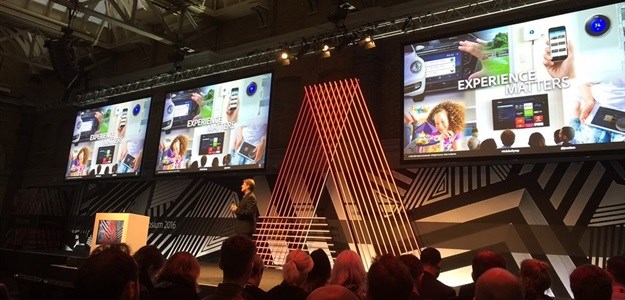Last week, Adobe hosted their annual Symposium in London with the theme 'Customer experience comes first.'
The day was packed with inspiring stories and thought-provoking future thinking, including a compelling presentation from Dr Chris Brauer, director of innovation at Goldsmiths College, on the findings of their latest research collaboration with Adobe on the Future of Experience. Another crowd favourite is a little closer to home; Craig Corte, head of design and customer experience at Barclays Africa shared, along with a few others, his story of their journey to digital transformation.
What really interested us was the regularity with which certain themes recurred during the day. Genuinely putting customer experience at the top of the agenda for any organisation requires fundamental change, not just in the technologies applied, but right across the board. It will require a change in thinking, a new way of working, a better understanding of the customer as a human being than ever before, and the courage to set daunting goals and to step outside of any preconceived comfort zone.
However, it was clear from the forerunners and early adopters in digital transformation, that the gain clearly far outweighs the pain. Here are some of the common themes around their journeys...
It’s emotional!
There’s so much talk of technology these days that it’s sometimes hard to remember that the focus of every customer journey is a human being. Consumers are not data models, they are not numbers and it is their hearts as well as their minds that brands are appealing to. Adobe’s research highlighted the importance of empathy between brand and consumer as a cornerstone of the customer experience. It is only in understanding the human being that organisations are really trying to connect with, that they can truly coexist in an experience. And as marketers strive towards an ever greater level of personalisation, that empathy is more important than ever.
The importance of creativity
If winning the hearts and minds of your audience is both an emotional and rational journey, it goes without saying that the message needs to deliver. Meaningful content and relevant, timely delivery are a brand’s greatest assets – every single interaction is a potential gain or loss. Ian Haworth, European creative director of Wunderman, presented some of their latest campaigns from around the globe and showed just how technology and creativity can work together to truly grab the attention of a particular target audience. From custom-built Aston Martins to a plate that gamifies mealtimes for tricky toddlers, customer insight combined with clever technology can drive the kind of creativity that converts trialists to fans and ultimately creates loyalists.
Set big goals
During Craig Corte’s session, someone asked how he set realistic goals. His fantastic answer was that he doesn’t set realistic goals. He challenged us to be brave and to set BHAGs – Big Hairy Audacious Goals. After all, When Uber set out to revolutionise the taxi industry without owning a single vehicle, some might have said that their goal was audacious. For any traditional business, the journey to becoming an experience-led business is long, arduous and bound to be uncomfortable along the way. You need to set goals, prioritise the core areas of focus and build your ROI case early.
Be adaptable
Traditional companies have a huge amount to learn from the new wave of disruptors. Simply promoting a CTO or CIO to the board is not going to bring about the fundamental organisational changes that are required to keep up. These days, startups sew technology into their DNA. In Dr Chris Brauer’s words, they have Silicon Boardrooms. They employ experience and journey managers, not product managers. In short, the experience is the product.

To successfully become an experience-led business, necessary and sometimes uncomfortable changes need to take place throughout. A new breed of people will be required, people with different skills. In the case of Absa, this meant bringing in people who understood customers first and foremost rather than banking. For Penguin Random House, it meant changing the way that people worked together so that previously siloed teams were co-located at least one day a week. It means giving people the right tools for the job. And it will almost certainly mean working agile which for many organisations represents a huge shift in pace and working patterns.
Keep testing
According to Adobe, 74% of consumers expect real-time responses from brands. This velocity of exchange between brand and consumer will not happen whilst working to the old rules, where we seek absolute perfection before we publish. Technology now makes testing campaigns a cost-effective reality – one in which consumers can define their experience ensuring truly customer-centric journeys. It’s also the means by which we can keep challenging, keep innovating and keep ahead.
It will be hard
Although all of these themes seemed to resonate with the majority of presenters and delegates at the Symposium, there was one thing on which everyone could agree: Change is hard. Human nature tends to be change and risk averse and it’s difficult to fix something that quite often won’t necessarily feel broken in the first place. As Jon Salt from Penguin Random House said, between the certainty of the current situation and the hope of something better, comes a huge amount of doubt. The Valley of Despair on the change curve. And in order to get to hope and beyond, there will be failures. Forward-thinking organisations should see failure as feedback. Employees should be encouraged to dare to fail – that’s where real progress and innovation begins.
These six themes have certainly given us plenty of food for thought. I’d highly recommend Adobe’s report as a little ‘light reading’.








































